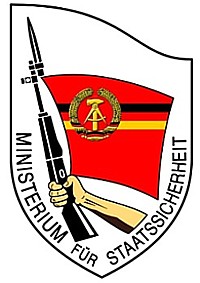Book Essay (back
to top)
In his book, Stasi: The East German Secret Police John Koehler
describes the Stasi as one of the most vicious intelligence agencies in
history. He usually compares them to the widely known German Gestapo.
Koehler makes comparison when he wants to emphasize the extent of harm
that the Stasi did to its prisoners. This book is biasedin that it makes
the Stasi seem like the most horrific secret police the world has ever
seen. The people they held and tortured were nothing compared to the tragedies
of the Gestapo. The book exploits only the worst things the Stasi did
and makes it seem worse than it actually was. Through examples I will
show how the Stasi compares to the Gestapo to show that the book takes
their reign out of context.
The Stasi and their leader
The Stasi was the East German police during the Cold War and the rise
and eventual fall of the Berlin Wall. The Stasi helped build the wall
to separate East and West Berlin in 1961. Prior to 1945 its future leader
Erich Mielke was a young boy, brought up in Hitler Youth, who later became
a solid supporter of East Germany. As a young man Mielke was involved
in a scheme to assassinate a Berlin Police officer. He was hated because
he broke up riots that the Communist Party held. At this time he was working
for two henchmen who worked in collaboration with Stalin. After working
for the Soviet Secret Police, "Obedinennoe gosudarstvennoe politicheskoe
upravlenie (OGPU)" (Koehler pg.43-44), the Soviet force worked
with the German State Security and Mielke became part of the newly formed
East German Secret Police force, the Stasi. In 1957 Mielke was made the
leader of the Stasi and restructured the force from the inside out. He
started to make it an espionage center. Soon thereafter the Berlin Wall
was erected and massive surveillance spread over East Germany. Mielke
wanted to make sure no one was leaving. Even though Mielke may have been
the leader of the Stasi, he was not an evil person. It was his responsibility
to keep East Germans unified and many people helped the Stasi in every
way they could, even if it meant they had to serve time in prison for
the rest of their life. As it will show in comparison to the Gestapo,
instead of being made to comply, people wanted to help.
The Statistics of Brutality Done By the Gestapo and Stasi
The Gestapo was the German secret police during World War Two and was
one of the most feared organizations to ever enforce "law" in
a country. Koehler uses individual cases to compare the Stasi to the German
Gestapo. He would like his readers to believe that they were as vicious
and controlling as the Gestapo. Then Gestapo was a Nazi organization that
worked for Adolf Hitler. Their main job was to "round up all the
Jews and the other ‘undesirables’ living within Germany’s newly conquered
territories, and to either send them to concentration camps or put them
to death," (Gutman pg.1). They were a force to be reckoned with.
They were not out to bring peace to Germany, they were out to kill whomever
Hitler deemed unfit to live in society.
The Stasi on the other hand wanted to keep East Germans happy and give
them a sense of security and show loyalty to the communist party. Simon
Wiesenthal of Vienna says, "‘The Stasi was much worse than the Gestapo,
if you consider only the oppression of its own people,’" (Koehler
pg.8). He is talking about the number of spies they set up against their
own people. The Stasi had an astonishing number of around four hundred
thousand while the Gestapo only had one hundred sixty thousand.
Readers must take into consideration the differences in the jobs the
two organizations had: killing, or spying. Torture was also a large part
of both regimes’ work. The full number of murders at the hands of the
Gestapo will never be known. As one author writes, "The Gestapo carried
out mass murders of hundreds of thousands of civilians of occupied countries
as a part of the Nazi program to exterminate political and radical undesirables,"
(Pike, pg.2). This huge number of murders does not include the extermination
of at least six million Jewish people. The Stasi's statistics are not
as ‘impressive’: Koehler writes that one of "Kitlaus’s major tasks
in 1998 was the investigation of wrongful deaths, including 73 murders,
30 attempted murders, 583 cases of manslaughter, 2,983 instances attempted
manslaughter, and 425 suspicious deaths" (Koehler, pg.9). The statistics
tell readers that the total number of deaths inflicted by the Stasi is
one thousand eighty-one people. This is a tangible number compared to
the number of deaths produced by the Gestapo.
Most of the Stasi’s prisoners were purely political because they were
spying for one of the Western powers, usually the United States. There
are accounts of people who had to endure torture at the hands of Stasi
officials. A man named Anton Ivankovic was taken into custody by the East
German secret police on April 27, 1988. He was taken to a secret location
where he was tied to a bed, given a sedative, and beaten for several days.
He was supplying manpower to the West, and the East wanted his company
to go under, which they succeeded in doing. They charged him with economic
sabotage and political subversion. After the torture "The doctors
diagnosed physical exhaustion, sleeping disorder, traumatic fear and an
irregular heart rhythm," (Koehler pg.97). This was the extent of
damage that happened to Anton. It is horrible, but far short of what the
Gestapo did to its victims.
Koehler is hard to believe most of the time because his only evidence
is the reports and interviews he gets by other people. After the above
diagnosis was made a person who held a high position in the Stasi, Wiegand,
"officially opened the investigation into the Ivankovic affair,"
(Koehler pg.98). Wiegand was the counterespionage director who reported
directly to Mielke. It seems that Stasi employees were doing what they
wanted and did not take directions from their superiors, which shows little
or no loyalty. The Stasi leader seemed to be disgusted that officers would
use torture to get what they wanted out of a prisoner.
The Gestapo, on the other hand, had an official policy of torture. "The
army units within the Gestapo were taught many torture techniques,"
(Gutman, pg.1). It seemed that whatever the Gestapo wanted to do, they
were allowed to. If they wanted to get information they first interrogated
the prisoner for hours. If they did not say anything, by an account of
one man, "I was thrown on a bed and whipped with a leather dog whip,"
(Simkin, pg.5). Then after that they interrogate them again. Many people
died during interrogations done by the Gestapo, but not by the Stasi.
This is not to say that the Stasi was not cruel, it is just shows that
Koehler should not compare the Stasi to the Gestapo.
What Jobs Were Held by these organizations
The Gestapo was a dedicated group that would stop at nothing to be rid
of the undesirable people, no matter what it took. Most of the people
who worked for the Gestapo were recruited because they worked for the
German army and were made to work for the horrible government that held
office. During the end of the regime the Royal Air Force bombed Gestapo
headquarters and destroyed most of the evidence that could have been used
to convict top Gestapo operatives. The Stasi was made up of people who
joined forces to help East Germany from losing minds and workers to the
West.
Many people infiltrated Western countries during the time of the Cold
War to protect their homeland. One of the Stasi informants was able to
bring down the Chancellor Willy Brandt. Willy Brandt was trying to unify
Germany with "cooperation not confrontation." A man named Günter
Guillaume who got the job as a personal assistant to Chancellor Brandt.
He was able to share with the Stasi and the Soviets foreign and emergency
contingency plans for the Western and NATO allies. The Eastern bloc had
a huge advantage if any kind of confrontation would have occurred. The
spy, who was finally caught, had enough time to seriously damage the Western
allies and discredit Willy Brandt in every way. There were also smaller
jobs that were done, and they were always successful, or that’s how Koehler
describes it. There is not one instance in which Koehler tells a story
of a spy that fails.
The Intelligence Branch
The Stasi was not only a foreign spy organization, since they had a big
branch that worked as an intelligence agency like the United States FBI.
The Stasi used a system of smell to scope out spies or people who might
damage the East Germans’ grand scheme to become a super power. It was
a said that "Stasi reports revealed that the pieces of cloth were
impregnated with the body odors of suspected dissidents who could thus
be tracked by bloodhounds," (Koehler, pg.144). It almost seems like
a joke. Koehler does highlight this technique as something that might
have been an extreme help in tracking down people. "Stasi agents
collected scent samples from people by wiping bits of cloth on objects
they had touched," (CNN, pg.1). One might think that the best agency
for keeping track of espionage spies might have been more advanced. By
the 1980’s it would seem that they might have discovered something more
sophisticated then using dogs to find offenders.
In the book Koehler seems to exaggerate events that happened under the
Stasi. Whenever a hostage was taken he always describes it as "grotesque,"
(Koehler, pg.143). He is a journalistic writer and is very good at describing
things so that readers get wrapped up in whatever he is talking about
and believe that what he says is true. Readers should realize that Koehler
looks at the Stasi in a biased way. Everything he says and the things
he explains should be looked at with a cautious eye. Readers should also
realize that most of the information he collected was taken from interviews
he had with people. People can lie and exaggerate when they try to remember
what happened.
|

